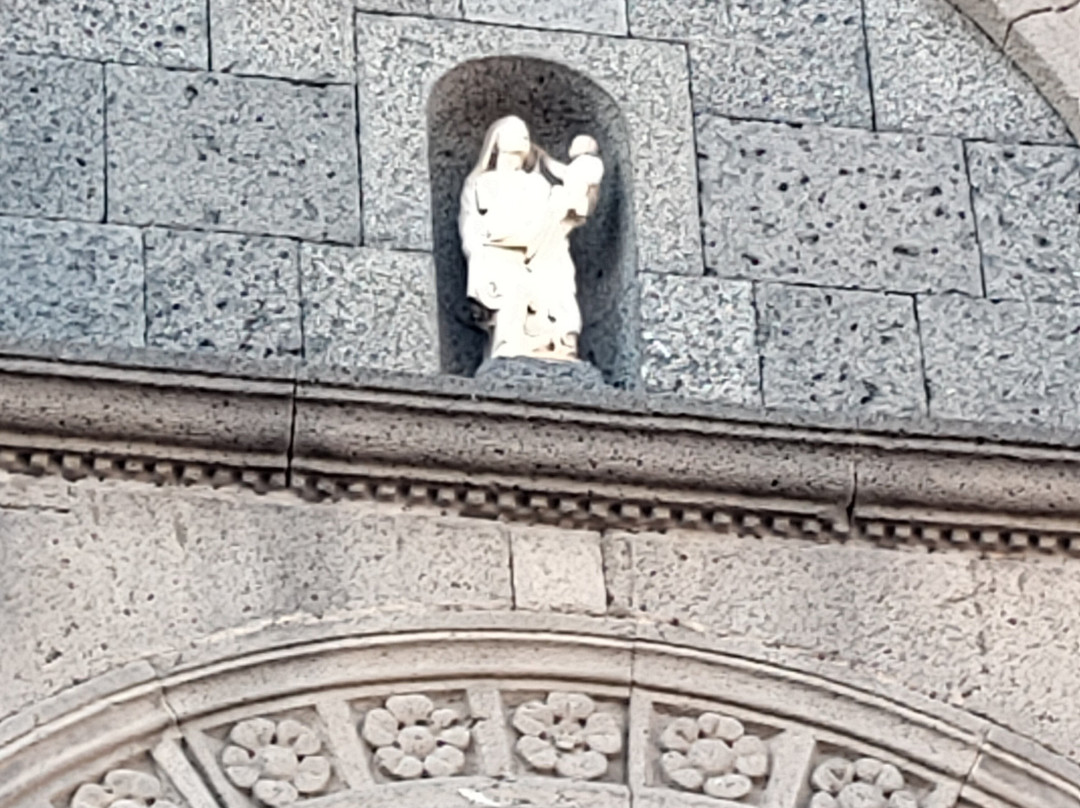的点评
Brunelleschi in the middle of the lava fields of Etna.
Basilica di Santa Maria的点评
点评:Don't get me wrong: the Florentine architect never traveled in this region.
However, entering this church, the reference to Brunelleschi's greatest basilica creations is evident: the interior "mimics" San Lorenzo and Santo Spirito in Florence.
The phenomenon is explainable: one of the renovations of this church - originally of architecture from the first half of the 13th century, purely Frederickian - is due to the Tuscan architect Luigi Calamech (1589). He introduced the structure featuring three naves, with two rows of monolithic basalt columns, supporting high Corinthian capitals with stone "dices", and connected to each other by Renaissance arches. Brunelleschi, precisely.
For the rest, the part that has reached us least altered by the transformations appears to be the complex of three very high apses, which contribute to giving the sensation of a fortress-church. The south-facing side of the church is also well preserved, but it saw the insertion of a beautiful Gothic-Catalan portal from the 15th century. The subsequent interventions are due to the well-known architect from Palermo Venanzio Marvuglia (late 18th-early 19th century), with the creation of the dome; while the renovation of the façade falls in the mid-19th century.
Overall, after the great Norman cathedrals, this appears to be one of the most notable churches in Sicily as for building effort. A phenomenon that is well explained, if one considers that Randazzo stood on the “regia trazzera” (royal sheep track) Palermo-Messina, therefore on the most important land communication route in Sicily.
However, entering this church, the reference to Brunelleschi's greatest basilica creations is evident: the interior "mimics" San Lorenzo and Santo Spirito in Florence.
The phenomenon is explainable: one of the renovations of this church - originally of architecture from the first half of the 13th century, purely Frederickian - is due to the Tuscan architect Luigi Calamech (1589). He introduced the structure featuring three naves, with two rows of monolithic basalt columns, supporting high Corinthian capitals with stone "dices", and connected to each other by Renaissance arches. Brunelleschi, precisely.
For the rest, the part that has reached us least altered by the transformations appears to be the complex of three very high apses, which contribute to giving the sensation of a fortress-church. The south-facing side of the church is also well preserved, but it saw the insertion of a beautiful Gothic-Catalan portal from the 15th century. The subsequent interventions are due to the well-known architect from Palermo Venanzio Marvuglia (late 18th-early 19th century), with the creation of the dome; while the renovation of the façade falls in the mid-19th century.
Overall, after the great Norman cathedrals, this appears to be one of the most notable churches in Sicily as for building effort. A phenomenon that is well explained, if one considers that Randazzo stood on the “regia trazzera” (royal sheep track) Palermo-Messina, therefore on the most important land communication route in Sicily.
翻译:别误会我的意思:这位佛罗伦萨建筑师从未到过这个地区。
然而,进入这座教堂,就会发现布鲁内莱斯基最伟大的教堂作品:内部“模仿”了佛罗伦萨的圣洛伦佐和圣灵大教堂。
这种现象是可以解释的:这座教堂的一次翻修——最初是 13 世纪上半叶纯粹的腓特烈式建筑——归功于托斯卡纳建筑师 Luigi Calamech (1589)。他引入了具有三个中殿的结构,两排整体玄武岩柱,用石制“骰子”支撑高大的科林斯柱头,并通过文艺复兴时期的拱门相互连接。正是布鲁内莱斯基。
至于其余部分,我们注意到的改造最少的部分似乎是三个非常高的后殿的复合体,它们给人一种堡垒教堂的感觉。教堂的南侧也保存完好,但增加了一个 15 世纪的哥特式加泰罗尼亚门廊。随后的干预措施由巴勒莫著名建筑师 Venanzio Marvuglia(18 世纪末至 19 世纪初)完成,包括建造圆顶;而正面的翻新则在 19 世纪中叶进行。
总体而言,继伟大的诺曼大教堂之后,这座教堂似乎是西西里岛建筑最杰出的教堂之一。如果考虑到 Randazzo 位于巴勒莫-墨西拿的“regia trazzera”(皇家绵羊道)上,因此位于西西里岛最重要的陆上交通路线上,这一现象就很容易解释。
然而,进入这座教堂,就会发现布鲁内莱斯基最伟大的教堂作品:内部“模仿”了佛罗伦萨的圣洛伦佐和圣灵大教堂。
这种现象是可以解释的:这座教堂的一次翻修——最初是 13 世纪上半叶纯粹的腓特烈式建筑——归功于托斯卡纳建筑师 Luigi Calamech (1589)。他引入了具有三个中殿的结构,两排整体玄武岩柱,用石制“骰子”支撑高大的科林斯柱头,并通过文艺复兴时期的拱门相互连接。正是布鲁内莱斯基。
至于其余部分,我们注意到的改造最少的部分似乎是三个非常高的后殿的复合体,它们给人一种堡垒教堂的感觉。教堂的南侧也保存完好,但增加了一个 15 世纪的哥特式加泰罗尼亚门廊。随后的干预措施由巴勒莫著名建筑师 Venanzio Marvuglia(18 世纪末至 19 世纪初)完成,包括建造圆顶;而正面的翻新则在 19 世纪中叶进行。
总体而言,继伟大的诺曼大教堂之后,这座教堂似乎是西西里岛建筑最杰出的教堂之一。如果考虑到 Randazzo 位于巴勒莫-墨西拿的“regia trazzera”(皇家绵羊道)上,因此位于西西里岛最重要的陆上交通路线上,这一现象就很容易解释。

此点评仅代表旅行者个人的主观意见,并不代表TripAdvisor以及其合作方的意见。
关于我们
|
新闻动态
|
商务合作
|
会员中心
|
业主中心
|
业主通
|
常见问题
|
意见反馈
|
联系我们
|
营业执照
© 2025 Tripadvisor 版权所有。
使用条款 |隐私政策 |网站工作原理
部分照片由 VFM Leonardo 提供。
* Tripadvisor不是旅行社,也不是旅游预订服务代理商。我们提供免费、客观、公正的旅游资讯服务。 (显示更多)
TripAdvisor LLC 既不是预订代理商,也不是旅游运营商,不会向网站用户收取任何服务费。 按照规定,在 Tripadvisor 发布机票价格、游览和旅行套餐的合作伙伴(航空公司、旅行提供商及预订代理商),其标价须包含所有费用和附加费用。 例如, 机场出入境税费、消费税与其他服务费、手续费、杂费及附加费用。 当您向我们的某个合作伙伴进行预订时,请务必查阅他们的网站以了解当地行政部门要求的所有适用费用的具体情况。 除非另有说明,机票价格通常指的是一个人的价格(以人民币计)。
为方便起见,TripAdvisor LLC 根据从我们的预订合作伙伴获取的空房率计算每个酒店的均价。 对于游览和景点来说,所显示价格通常是每位成人的最低可用价格。 对于列出的任何旅行套餐或优惠,TripAdvisor LLC 无法保证任何特定的费率或价格。 此外,酒店均价每晚会更新,并以您的首选币种表示(使用现行汇率)。 由于这些已换算的价格是预估价格,因此,有关具体金额和币种请与预订网站进行核实。
此外,TripAdvisor LLC 无法保证我们网站上宣传的价格随时有效。 标价可能需要预订一定天数才能生效,或有不可用日期、使用条件或限制。
TripAdvisor公司对外部网站的内容一概不负责。优惠价格中不含税和其他费用。
ICP证:沪B2-20200433
沪ICP备20013175号
 沪公网安备31010502005427号
沪公网安备31010502005427号鹰程信息技术(上海)有限公司
货币/国家及地区
¥CNY
中国

